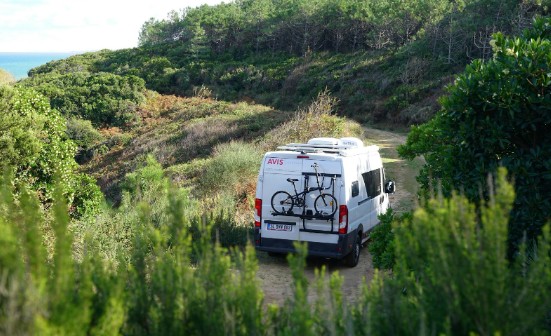
Cover Photo by Kampbros on Unsplash
I live in an RV, and my fixed costs amount to less than $600 per month. I’m sharing my best advice for RV-ing on a budget.
Traveling can be expensive, but it doesn’t have to be. In an effort to get more people to enjoy the great outdoors and experience extended travel, I’m sharing my budget—yes, my real budget—as a full-time van-dweller. It’s time that we full-time travelers start bearing the truth about what it takes to live the lifestyle that social media has glamorized.
What I Spend Each Month Living in a Van
Here’s how much it costs to live in a converted campervan, based on real figures from a real person living in a van.
Fixed monthly costs: $541
- Vehicle note: $0/month (paid off)
- Campsite fees: $0/month (we boondock)
- Electricity: $0 (solar-powered electricity)
- Water: $0/month
- Phone bill: $85/month (1 line, unlimited cell phone data, 100GB hotspot data)
- WiFi: $165/month
- Van insurance: $140/month (full coverage)
- Satellite messenger plan (in case of emergencies): $12/month
- Netflix standard plan: $18/month
- Business insurance: $24/month
- Cloud storage: $5/month
- Apple Music: $11/month
- Other subscriptions, including annually billed plans: $81
Variable, recurring monthly costs: Approximately $1,220 during a good month to $2,640 during a spendy month
- Diesel: Varies significantly based on region and speed of travel, but usually between $500 and $1,200/month
- Propane: $20–$40/month
- Groceries: $400–$600/month (two very active and hungry people)
- Pet care (dog food, cat food, cat litter, toys, etc.): $200–$300/month (two large dogs, two cats)
- Restaurants and drinks: $100–$400/month, including a plethora of gas station coffees on long drive days
Variable, non-recurring costs: Approximately $0–$2,500+
The rest of my costs come from things like camping and hiking gear, guide service fees, one-off annual purchases (like my America the Beautiful National Parks Pass, $80), trailhead parking, van repairs and vehicle maintenance, vet visits, business expenses, and unexpected costs like hotel stays if the van needs a repair that wasn’t planned for. These costs can be $0 one month and thousands the next. It just depends on where we are, what we’re doing, and luck as the universe would have it, like in any other living situation.
Total monthly costs, low end: $1,761
Total monthly costs, high end: $5,681
The truth is, actually hitting either of those numbers is very rare—especially the low end. My costs typically fall somewhere in the middle, but I do sometimes (OK, frequently) experience dramatic swings. That’s part of why budgeting for vanlife is so challenging—things are rarely the same from one month to the next.
How to Lower Your Costs as an RV-Dweller
The main factor driving my fixed monthly costs is that I don’t have a vehicle note. I was fortunate to be able to sell a home that I owned and use the funds from that sale to buy my van in cash. However, even if buying your RV or van in cash is not an option for you, there are plenty of ways to keep costs down. Here are my top tips to save money while living in an RV.
Boondock
Boondocking refers to camping in informal camping areas, such as on National Forest or Bureau of Land Management land. Typically, boondocking sites do not have any amenities at all, so your rig must be self-contained and powered, either through solar or a generator.
Fill Up Freshwater Tanks for Free
In the U.S., finding fresh water for free is not difficult. Many interstate rest areas have potable water spigots, as do local, municipal, county, and state parks. Even many campgrounds and forest ranger stations will let you fill up at no cost. When in doubt, just ask!
Use a Refillable Propane Tank
Ditch single-use, 1-pound propane canisters and get a refillable tank instead. This brings the cost of propane itself down significantly, and it’s better for the environment as you’ll produce less waste.
Use Refillable Water Bottles
Stop buying disposable water bottles, even if you’re just camping for a weekend. Refillable bottles and jugs allow you to get water for free at fountains in public places, and they minimize waste.
Invest in Great Solar
If you have solar panels, you can boondock, saving money on campsite fees. It also reduces fuel costs, since you won’t need gasoline, diesel, propane, or butane to run appliances that are hooked up to your electrical system.
Make Meals in Your RV
After a long day of driving or adventuring, it is tempting to go eat at a restaurant. By having ingredients for simple meals on hand and cooking in your RV, you can save a lot of money. It’s usually healthier, too! (See my top tips for staying fit while living on the road).
Do Free Activities
You don’t need to spend a ton to have fun while traveling. Prioritize free and low-cost activities like hiking, sightseeing, and stargazing. Also, look into free admission days for zoos, museums, galleries, and other locations.
Use a Multi-Carrier WiFi Hotspot
When I started vanlife, I paid for multiple hotspot devices and plans from multiple carriers so that I could minimize gaps in coverage. However, it’s generally more cost-effective to use a multi-carrier hotspot, like TravlFi’s JourneyGo device. This way, you pay just one fee for access to major networks in your area.
Sign Up for Member Discounts
Being a part of organizations like Thousand Trails, Escapees RV Club, Passport America, Good Sam Club, and Harvest Hosts can help you stack up the savings. These member clubs offer discounts for campsites, dump station fees, roadside assistance, and more.
Use Fuel and Grocery Rewards Programs
Signing up for grocery store and gas station reward programs is typically free and can save you a ton of dough over the long haul. A $0.10 discount per gallon of gas makes a big difference when you fill up a large fuel tank frequently!
Take Full Advantage of Hookups
Use electricity that’s included in the campsite fee instead of running your generator or propane, if your rig allows for that. And if you’re going from a campground to a boondocking site, fill up your water tanks before you head out. You paid for it!
Keep Up With Maintenance
Retroactive repairs always cost more than proactive maintenance. Make sure to have your rig regularly inspected and complete all suggested maintenance on time.
Travel Slowly
My biggest tip of all? Take your time. Traveling fast means you’ll spend more on fuel, and it’s often cheaper to book campsites for a week or a month compared to just a night or two. Plus, traveling quickly is tiring and can lead to spending more on food from restaurants instead of cooking meals in your RV.
FAQs
How much should I budget for full time RVing?
Just like budgeting for living in an apartment or home, budgeting for RV living is highly individual and specific to each family’s needs. I can’t tell you how much to budget—only you know your financial situation. Full-time RV living can be just as expensive as living in a traditional home, so it’s important to plan ahead and make a budget based on your income and expected expenses.
Is RVing cheaper than hotels?
Yes, RVing is generally cheaper than staying in hotels, but not always. It depends on the region you’re traveling to, the type of campsite you book, and other factors, like if you’re traveling on a holiday weekend.
Is it cheaper to rent or buy an RV?
If you’ll use your RV several times per year or live in it full-time, the financially smart decision is to buy. However, if you only go RVing once or twice a year, it makes sense to rent.
Did You Like This Post? Read More Like It:
- How to Make Your RV More Secure: Keep Yourself and Your Stuff Safe
- RV Must-Have Accessories: Top Picks to Make Every Trip a Smooth One
- Common Travel Mistakes for New RV-ers to Avoid
Learn More about how TravlFi can help you stay connected on the road.

Article By: Amanda Capritto
Amanda Capritto is a fitness and outdoors journalist who travels full-time in a Winnebago camper van. Her work has appeared in national and global outlets like Lonely Planet, Reader's Digest, CleverHiker, CNET, and more.
